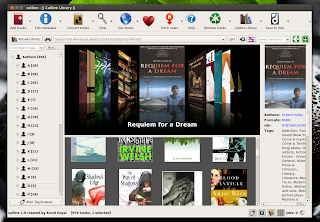Calibre is an open source tool to manage e-books, which features e-book syncing with popular e-book readers, library management and e-book conversion between various formats. The application is available for Linux, Windows and Mac OS X.
The latest Calibre 1.0, released recently, features a new cover grid view of the books available in the Calibre library, a faster database backend and more.
With Calibre 1.0, an optional grid view which displays books by cover has been added. To switch to it, click the grid icon in the bottom right corner:
 |
| The new Calibre grid view |
The grid view is customizable via Preferences > Look & Feel > Cover Grid. Here, you can change the cover height and width, enable displaying the book title below the cover, set the cover cache size and so on.
Another interesting feature that was added to Calibre 1.0 is called "Virtual Library". Using virtual libraries, Calibre can split big libraries into smaller virtual libraries. The virtual libraries are created based on a search expression and when using such a library, Calibre behaves like it only contains the matched books so the application only displays the tags/authors/series etc. that belong to the virtual library. To create a virtual library, click "Virtual Library" on the left of the search bar, then select "Create Virtual Library":
 |
| Calibre Virtual Libraries |
This can be useful to easily create a library with your favorite authors, unread books and so on.
Also, with version 1.0, Calibre can scan your computer for all TTF and OTF fonts used in documnts and automatically embed them. Further more, Calibre can "subset" fonts, meaning it can reduce their size by using only the glyphs present in the document. This option can be turned on via the Look & Feel section of the conversion dialog ("Embed referenced fonts").
Other changes in the latest Calibre 1.0 (compared to 0.9.0)
- The database backend has been re-written from scratch and should be 2-3 times faster than the old one;
- A new Microsoft word (docx generated by Word 2007 or newer) converter has been added to Calibre;
- New metadata sources have been added, including Google Image search, Edelweiss and Big Book Search;
- Re-written PDF output engine which should now support proper pagination, inserting headers and footers with templates, auto generation of a printable Table of Contents and more;
- A new "Polish books" tool lets you perform various cleanup actions on ebooks such as embedding fonts, smarten punctuation, update the metadata and more. To use this tool, go to Preferences > Toolbar and add the Polish books tool to the main toolbar. This tool only works with EPUB and AZW3 formats;
- A new ToC edit tool lets you re-arrange entries in the Table of Contents. To use it, go to Preferences > Toolbar and add the Edit ToC button to the main toolbar.
 |
| Calibre metadata sources |
 |
| The new "Polish books" tool |
Install Calibre in Ubuntu
Ubuntu 13.10 Saucy Salamander: Calibre 1.0 has just been uploaded to the Saucy repositories so it should be available via Ubuntu Software Center in a few minutes.
For older Ubuntu versions, you have two options:
A. Using a PPA for Ubuntu 13.04 or 12.04 - the PPAs currently have Calibre 0.9.41 but hopefully they will be updated to the latest Calibre 1.0 soon.
Using the current version in the PPAs, you won't get the new grid view but other features such as the new Virtual Library, Polish Books, Edit ToC or the new metadata sources should already be available.
Using the current version in the PPAs, you won't get the new grid view but other features such as the new Virtual Library, Polish Books, Edit ToC or the new metadata sources should already be available.
To install Calibre in Ubuntu 13.04, use the following commands:
sudo add-apt-repository ppa:n-muench/calibre
sudo apt-get update
sudo apt-get install calibreOr, if you're using Ubuntu 12.04, use the commands below:
sudo add-apt-repository ppa:n-muench/calibre2
sudo apt-get update
sudo apt-get install calibreB. Using the official binary Calibre 1.0 binary that includes private versions of all its dependencies. This should work with any Ubuntu version as well as other Linux distributions as long as you have glibc 2.10 or higher and xdg-utils and python ≥ 2.6 installed. But there is a downside: there is no uninstaller so if you want to remove Calibre, you must remove the folder it creates under /opt as well as all the files it installs under /usr/local/share/applications and so on.
Before using the official installer, it's recommended you remove any Calibre versions you may have installed from PPA or official repositories:
sudo apt-get remove calibre calibre-binTo install Calibre using this method, use the following command:
sudo python -c "import sys; py3 = sys.version_info[0] > 2; u = __import__('urllib.request' if py3 else 'urllib', fromlist=1); exec(u.urlopen('http://status.calibre-ebook.com/linux_installer').read()); main()"Download Calibre (for Linux, Windows or Mac OS X)

0 comments:
Post a Comment